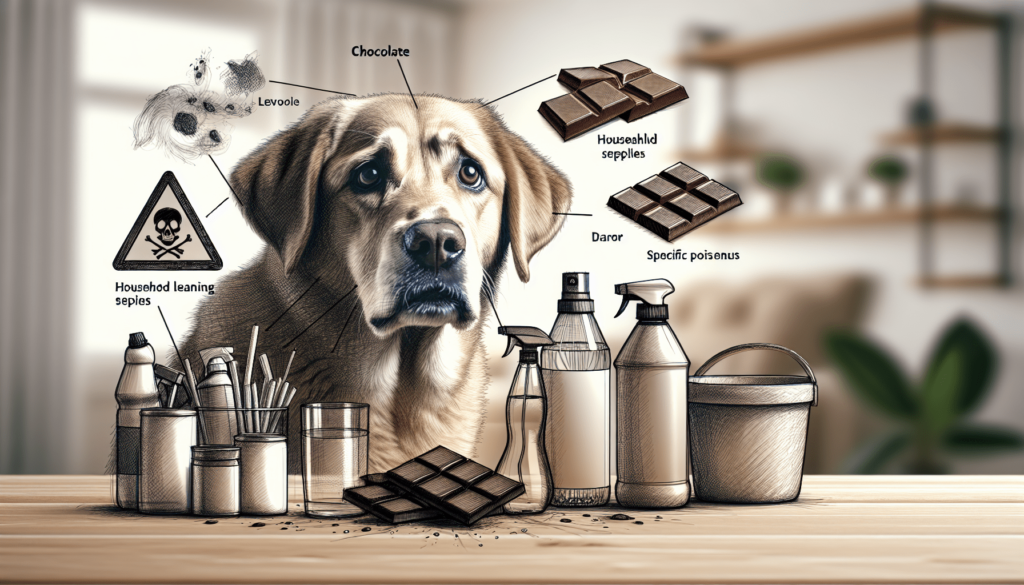When your furry friend is exposed to a harmful substance, it can be a nerve-wracking experience. In “How Long Does It Take For A Dog To Show Signs Of Poisoning?”, you’ll discover the various factors that influence how quickly symptoms might appear. From the type of poison and the amount ingested to your dog’s size and overall health, every detail matters. This article is designed to provide you with essential information so that you can act swiftly and knowledgeably in case of an emergency. Have you ever wondered how long it would take for your dog to show signs of poisoning? It’s a scary thought, I know. Our furry friends rely on us to keep them safe, and understanding the symptoms and timelines of poisoning can be crucial in providing them timely help. Learning about the various factors and symptoms can help you act quickly and effectively if you ever find yourself in this unfortunate situation.
Introduction to Dog Poisoning
Dogs are curious creatures by nature, often exploring the world with their noses and mouths. This curiosity, while charming, can sometimes lead them to ingest or come into contact with harmful substances. Poisoning in dogs can stem from various sources, including household chemicals, plants, foods, and medications.
Common Causes of Dog Poisoning
To prevent poisoning, it helps to be aware of the most common culprits:
- Foods: Chocolate, grapes, raisins, onions, garlic, xylitol (a sugar substitute) can be toxic to dogs.
- Household Chemicals: Rodenticides, antifreeze, cleaning products, and some cosmetics.
- Medications: Human medications like ibuprofen, acetaminophen, and certain antidepressants.
- Plants: Sago palms, oleander, foxglove, and lilies, among others.
By knowing these common sources, you can take measures to keep them out of your dog’s reach.
Immediate and Delayed Symptoms of Dog Poisoning
The timeline for symptoms can vary significantly based on the type of poison, the quantity ingested, and the size and health condition of your dog. Let’s break down the symptoms into immediate and delayed categories for a clearer understanding.
Immediate Symptoms (Within Minutes to Hours)
Some poisons cause rapid symptoms that can appear within minutes to a few hours. These fast-acting poisons can be particularly dangerous because they require swift identification and intervention.
Examples of Symptoms:
- Vomiting and Diarrhea: Often one of the first signs, as the body attempts to expel the toxin.
- Drooling: Increased salivation can indicate nausea or an attempt to clear a bitter taste.
- Lethargy or Weakness: A steep drop in energy levels.
- Seizures or Tremors: Nervous system involvement could lead to shaking or convulsing.
- Difficulty Breathing: Labored or shallow breathing can signal respiratory distress.
Delayed Symptoms (Several Hours to Days)
Other types of poisons have a delayed onset, complicating early detection and treatment. These poisons might initially appear harmless or cause subtle symptoms that progressively worsen.
Examples of Symptoms:
- Lack of Coordination: Dizziness or imbalance can indicate neurological impairment.
- Jaundice: Yellowing of the gums, eyes, or skin points to liver issues.
- Abnormal Heart Rate: Irregularities in heartbeat or cardiovascular stress.
- Kidney Failure: Symptoms might include increased thirst and urination, or conversely, a lack of urine production.
- Behavioral Changes: Unusual aggression, anxiety, or other changes in demeanor.

Factors Influencing the Onset of Symptoms
Several key factors can influence how quickly a dog shows signs of poisoning. Understanding these can further prepare you to act promptly.
Type of Poison
Not all poisons are created equal. The chemical structure, potency, and method of absorption can greatly affect the timeline. For instance:
- Neurotoxins: Often found in insecticides and certain plants (like the sago palm), these can affect the nervous system almost immediately.
- Gastrointestinal Toxins: Foods like chocolate and xylitol are quick to cause vomiting and diarrhea.
- Systemic Toxins: Some poisons, like rodenticides (rat poison), may take time to disrupt internal systems like blood clotting mechanisms or kidney function.
Amount Ingested
The quantity of the toxic substance can be directly proportional to the speed and severity of symptoms. Smaller dogs are particularly vulnerable since even a small amount of poison can have a significant impact compared to a larger dog.
Dog’s Health Status
A dog’s age, weight, and overall health play critical roles. Puppies and senior dogs, due to their less robust immune systems, and dogs with preexisting health conditions may show signs faster or be more severely affected.
Route of Exposure
How your dog has been exposed to the toxin matters too. Ingested poisons tend to show symptoms more quickly than those absorbed through skin contact or inhalation, though this isn’t a hard and fast rule.
Confirming Poisoning
Recognition and confirmation of poisoning can sometimes be challenging, given the wide range of possible toxins and symptoms. Here’s how you can take steps to confirm it:
Observational Analysis
Keep an eye out for sudden and unexplained changes in your dog’s behavior or physical state. If there is any unusual mess such as vomit or diarrhea, inspect it carefully—though not too closely as it could be harmful to you as well.
History of Exposure
Reflect on the recent activities and environment of your dog. Know if they have ventured into potentially hazardous areas or ingested something unusual. This historical context can help veterinarians provide a faster and more accurate diagnosis.
Medical Assessments
Veterinary tools like blood tests, urinalysis, and imaging can give definitive information regarding the specific toxin and the extent of its effect on your dog. Always aim to get professional evaluation sooner rather than later.

First Aid and Immediate Actions
If you suspect your dog has been poisoned, acting quickly can make a big difference. Here are some steps to follow while you get your dog to the veterinarian.
Identify and Isolate the Poison
Secure any evidence of the suspected poison to bring with you. This can help the vet identify the toxin and choose the right treatment more effectively.
Do Not Induce Vomiting Without Guidance
While inducing vomiting might seem like a good idea, it can sometimes do more harm than good, especially if the poison can cause additional damage on the way back up. Always consult your vet or a poison control hotline first.
Use Activated Charcoal (If Advised)
In some cases, a vet may recommend giving your dog activated charcoal to help absorb toxins and limit absorption in the stomach. This should only be done under professional guidance.
Veterinary Treatment
Once you reach the vet, several treatment avenues may be explored, depending on the type of poison and the severity of symptoms.
Antidotes and Specific Treatments
For certain toxins, specific antidotes might be available. Quick administration can be life-saving but requires precise identification of the poison.
Supportive Care
Many poisoning cases warrant supportive care, which could include:
- IV Fluids: To prevent dehydration and facilitate toxin elimination.
- Medications: To control symptoms like seizures or to protect organs such as the liver and kidneys.
- Oxygen Therapy: If breathing is compromised.

Prevention Tips
Preventing poisoning is always better than dealing with its fallout. Being proactive can save you and your furry friend a lot of pain.
Safe Storage
Ensure all potentially harmful substances, including household cleaners, medications, and certain foods, are securely stored away from your pet’s reach.
Dog-Proofing Your Home
Consider identifying and dog-proofing areas in your home, particularly where chemicals or harmful foods are stored. Using child safety locks can offer an extra layer of security.
Educate Yourself on Toxic Plants
If you have a garden, familiarize yourself with plants that are toxic to dogs and avoid planting them. Some common examples include sago palms, oleander, and azaleas.
Regular Health Checkups
Routine veterinary checkups can help monitor your dog’s overall health and catch any problems early before they become severe. Vets can also provide specific advice tailored to your dog’s needs.
Conclusion
Understanding the timelines and symptoms of dog poisoning can be a life-saving measure. While it’s impossible to protect your pet from every hazard, being informed equips you with the knowledge needed to act swiftly and effectively. Should you ever find yourself in this unfortunate situation, early recognition and prompt medical attention are your best allies in ensuring your dog’s recovery.
By integrating this understanding into your daily life, you can help create a safer environment for your beloved furry family member.

